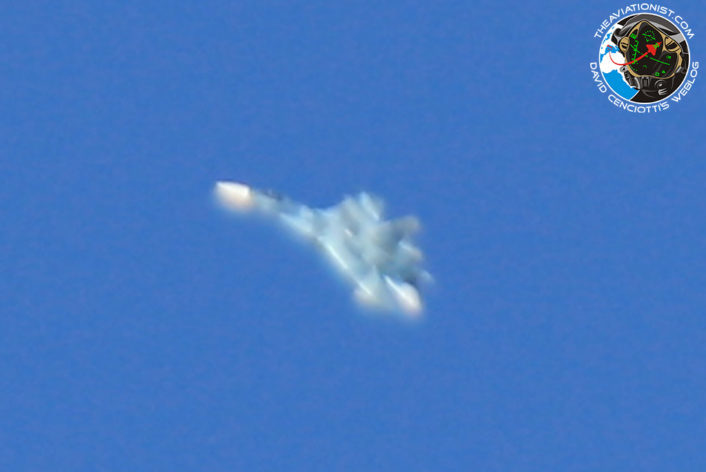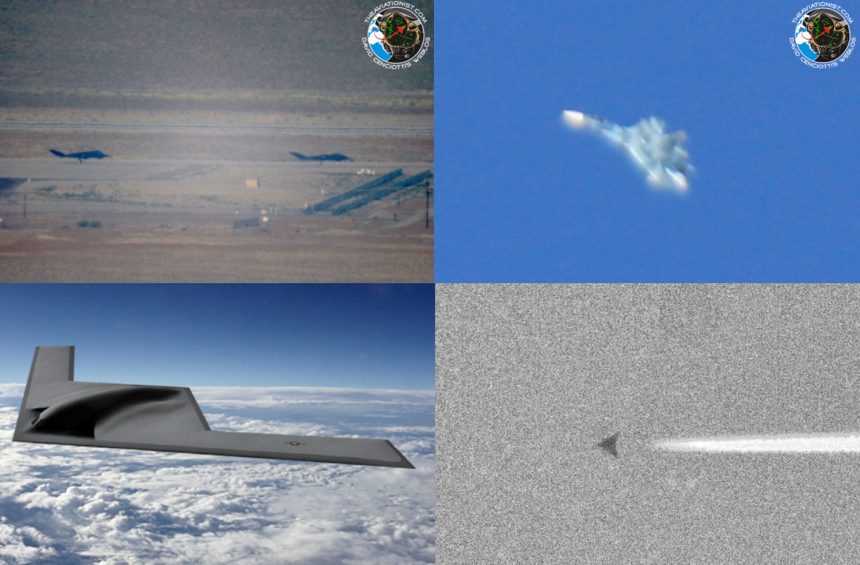Who Was F-35 Test Pilot Lt. Col. Eric Schultz and What He Was Flying When He Died?
The tragic loss and impressive career of U.S. Air Force pilot Lt. Col. Eric Schultz in a reported crash on Tuesday night has been overshadowed in Internet forums by speculation about what type of aircraft he was flying when the accident occurred. The type of aircraft remains classified according to Air Force sources.
Amid increasing speculation that the aircraft involved in the crash may have been an F-35, USAF Gen. David L. Goldfein, Chief of Staff of the Air Force, was quoted on Saturday morning, September 9, as telling Military.com, “I can definitely say it was not an F-35.”
#BREAKING: “I can definitely say it was not an F-35,” –@GenDaveGoldfein told @Militarydotcom accompanying him on trip to #NGAUS2017. https://t.co/5IlGYUqFdA
— Oriana Pawlyk (@Oriana0214) September 9, 2017
The comment by Gen. Goldfein to Military.com confirming that Col. Schultz was not flying an F-35 raises the question; what was Lt. Col. Eric Schultz flying when he was fatally injured in the crash this Tuesday?
The U.S. Air Force said the aircraft was operated by the Air Force Materiel Command and that it crashed around 6 PM, 100 miles Northwest of Nellis AFB in the Nevada Test and Training Range.
What was Lt. Col. Eric Schultz working on when he died from a crash earlier this week?
It is important to understand any examination of his activities are strictly conjecture as all official sources have declined to comment on the specifics of Lt. Col. Schultz’s assignment when he died.
With a practical background in tactical air combat from flying F-15E Strike Eagles and an academic and career background including powerplant engineering, Lt. Col Schultz could have been working on any number of classified projects.
There are several projects known to be operational or under development in the classified Nellis, Nevada and California area test ranges where Lt. Col. Schultz is reported to have had his now fatal accident.
The test and development programs include opposing forces threat simulation and testing using Russian built Sukhoi SU-27 (NATO codename “Flanker”) aircraft. These aircraft were photographed on November 8, 2016 by Phil Drake from the Tikaboo Valley near the Groom Lake, Nevada test range. Drake captured long range photos of an SU-27P Flanker-B engaging in dissimilar air combat maneuvers (ACM) with an F-16, possibly an F-16D, four of which are thought to operate from Groom Lake. It is possible that, with Lt. Col. Schultz’s involvement in the F-15E Strike Eagle community and his advanced academic background, he could have been involved in an advanced opposing forces capabilities benchmarking research project or in a familiarization program with opposing forces aircraft like the Sukhoi(s) photographed at Groom Lake.

Another classified project in the area is continued flight operations of the “retired” Lockheed F-117 Nighthawk presumably for radar cross section testing and analysis. The famous “stealth fighter” was photographed by our reader, “Sammamishman,” in late July, 2016. The photos showed two F-117 aircraft in the air and on the ground at the Groom Lake test facility 8 years after retirement.

Another test program that may be underway in the area, and that Lt. Col. Schultz may have been contributing to at the time of his fatal accident, is the classified Northrop Grumman B-21 Raider Long Range Strike Bomber (LRSB). The B-21 program is likely a replacement or augmentation to the currently operational B-2 Spirit stealth bomber. Artists’ depictions of the B-21 Raider suggest it is similar in configuration to the B-2 Spirit, but may be smaller. It likely still retains a crew of more than one person however, although an accident involving any potential prototype may not necessarily be fatal for an entire crew, however many that number may be. Recall the crash of the XB-70 Valkyrie on June 8, 1966. That large strategic bomber prototype had a two-person crew on board when it crashed due to a midair collision. The crash only resulted in one fatality, with the other aircrew member safely ejecting. There is, however, no public information on the potential flight status of the B-21 Raider program.

There is also the possibility aircraft was the same boomerang shaped trailing edge jet photographed on Mar. 10, 2014 by Steve Douglass and Dean Muskett at Amarillo International Airport or the triangular one seen over Wichita in the same period, or something else, never seen before.
However, whilst both the Su-27s (operated by the AFMC according to the Combat Aircraft’s editor Jamie Hunter), the F-117s and the two mysterious aircraft of 2014, were spotted flying in daylight, there is someone who believes a highly-classified prototype would hardly fly before sunset.
Sunset in Las Vegas on 8Sept was 6:58pm. Mystery aircraft crashed around 6pm. Surprising if USAF flew a black plane before sunset.
— Stephen Trimble (@FG_STrim) September 9, 2017
The reality of Lt. Col. Schultz’s tragic loss is that, while we know he was an accomplished aviator, test pilot and academic we likely will not know the actual circumstances of his accident or the aircraft he was operating until the Air Force chooses to make the information officially available. Until then, a survey of the known projects in the area where Lt. Col. Schultz’s accident unfortunately occurred is all we have.
The more relevant story however, is the noteworthy career of USAF Lt. Col. Eric “Doc” Schultz.
Lt. Col. Eric Schultz, call sign “Doc” because he owned a PhD in aeronautics from the California Institute of Technology in 2000, was an academic and award-winning pilot. At one point he was also an aspiring astronaut, having made application to astronaut training.
In one accounting of Lt. Col Schultz’s early academic career it is reported that after earning his undergraduate degree from Penn State in 1995, the Department of Defense paid for Schultz to earn a master’s degree in aeronautics and astronautics. His master’s work included research on the ram accelerator, a powerful gun-like device that shoots payloads into exo-atmospheric orbital flight in space. If perfected, the accelerator could be used in place of reusable spacecraft missions, like the X-47B, to transport equipment into orbit or to space stations.
Schultz graduated with his master’s degree in aeronautics in 1997 from the University of Washington.
According to a report published on October 4, 2006 in the Baltimore Sun by writer Susan Gvozdas, Col. Schultz “Received a National Defense Science and Engineering Fellowship to support his research on advanced propulsion systems and safety at nuclear waste storage facilities”.
Also according to news report archives, Lt. Col. Eric Schultz was rejected from the Air Force on five occasions for not meeting eyesight standards for pilots. After his early attempts at entering Air Force ROTC were rejected due to his eyesight, Schultz worked in a civilian capacity with the Navy as a flight engineer while continuing his graduate education.
Schultz’s prior work as a graduate assistant won the attention of jet engine manufacturer Pratt & Whitney based in Connecticut. According to a report, Erik Christofferson, a deputy general manager at Pratt’s Washington office, persuaded the company to hire Schultz. “He had the right combination of technical background and communication skills,” Christofferson said. “He was engaging and sharp.” According to the report Schultz worked on the development of detonation engines at Pratt & Whitney’s Seattle Aerosciences Center,.
He was finally awarded a commission after earning his PhD in aeronautics and undergoing corrective vision surgery.
Lt. Col. Schultz went on to fly the F-15E Strike Eagle for the 391st Fighter Squadron, the “Bold Tigers” out of Mountain Home AFB in Elmore County, southwestern Idaho. He may have been deployed to the Middle East with the unit in January of 2007 according to an excerpt in an article about Schultz that said he was, “preparing for overseas combat missions in an F-15 fighter jet and training other pilots”. We were not able to find any mention in the media about a combat record for Lt. Col. Schultz or even confirmation that he did deploy to the Middle East, only that he was scheduled to deploy.
There are acknowledgements of Lt. Col. Schultz’s academic and military achievements through awards he received and brief quotes in official Air Force releases. His former commanding officer, then Lt. Col. Brian Kirkwood, said in an article on Mountain Home AFB’s official website that, “He’s a great role model.” Lt. Col. Kirkwood went on to tell the official Air Force media outlet that Lt. Col. Schultz’s “educational background is unprecedented for an [then] Air Force captain.” Lt. Col. Kirkwood made the statements when acknowledging Lt. Col. Schultz for being awarded the Outstanding Young American award.
Based on the information available in the public domain so far, Lt. Col. Eric Schultz had amassed a noteworthy academic background and career that spanned several aspects of military and experimental aviation and aerospace. It may be the combination of these experiences in tactical aircraft operations and experimental powerplants along with space operations that is particularly noteworthy.
David Cenciotti has contributed to this story.
Top image: composite made using Northrop Grumman, Dean Muskett, Phil Drake and Sammamishman









